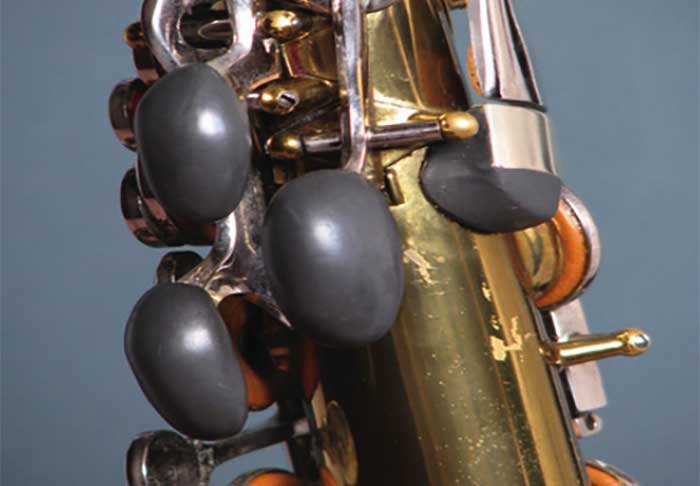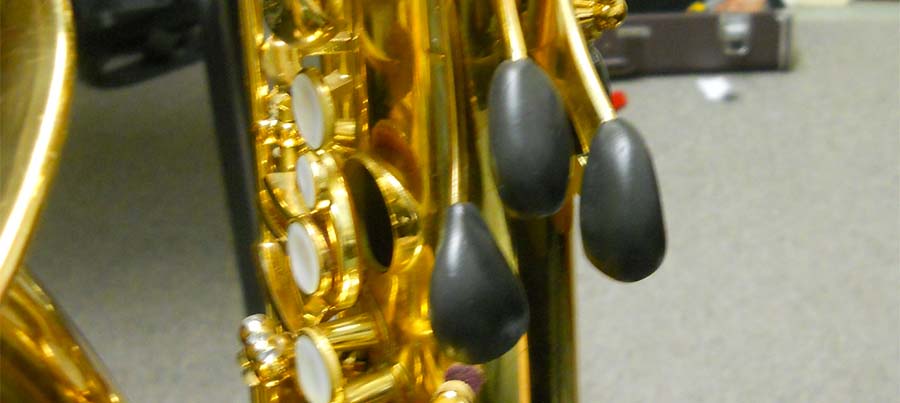Developing Technique Through the Use of Palm Key Risers

Introduction
For some saxophonists, developing palm key technique is a challenge. These keys, used to finger the notes of the upper register, specifically high D, Eb, E and F, can feel awkward to many performers since to depress these notes, the left-hand palm must be used. In addition, high E and F are notes whose fingerings require a combination of the left-hand palm along with fingers from both the left and right hands.
To compound matters, many saxophonists do not have the embouchure strength to work on these fingerings for extended periods of time since these notes are at the top of the normal written range for saxophone. Combine these factors with the fact that some saxophones are built with palm keys that are hard to reach and it is easy to see why palm key technique is lacking in many saxophonists.
The best solution to poor palm key technique is slow, perfect practice while keeping the hands close to the keys. However, for saxophonists who feel that the palm keys on their particular instrument are poorly designed or hard to reach, a solution, in addition to slow perfect practice, may be the use of palm key risers.
Palm Key Risers
Palm key risers are usually made from rubber and fit over the existing left-hand palm keys increasing their height and making them easier to reach. In addition, some saxophonists place risers on the right-hand side keys for the same purpose. Depending on the design of the saxophone, palm key risers may increase speed, accuracy and comfort, especially over fast musical passages, by reducing the amount of movement required to depress the keys. For performers who have repetitive strain injury, palm key risers may also provide some relief.
Two popular palm key riser manufacturers are Runyon and Oleg. Runyon produces inexpensive risers made of rubber that slip over existing palm keys. Oleg produces more expensive risers made of cast metal that attach to the instrument with set screws. Both of these products are good solutions to a poorly designed saxophone and can assist in the development of palm key technique.
Concerns
Several concerns with palm key risers are that they only come in one size for each saxophone type. This standard sizing may be too big or small for some performer’s hands and since the risers slip over existing palm keys, they may not be held securely in place. To overcome these issues, saxophonists sometimes hand-make their own risers out of cork and sand them down to the perfect size. However, cork risers and rubber palm key risers that do not fit well, must be glued to the instrument, which may damage the finish of the saxophone if the riser is removed.
Sugru

For saxophonists who would like to make their own palm key risers but are concerned about using cork and gluing it to their instrument, there is a new alternative call Sugru. Sugru feels like modeling clay but is actually silicone rubber that can be shaped for up to thirty minutes once it has been removed from its packaging and exposed to air. After curing for twenty-four hours at room temperature, Sugru is a soft, flexible, waterproof, temperature resistant material that will adhere to many different surfaces including aluminum, steel, ceramics, glass, wood and some plastics.
Sugru is inexpensive and can be easily purchased from online stores. It comes in a variety of colors and is often sold in a bundle of twelve individually wrapped packs with five grams of Sugru in each pack. The shelf life for Sugru is around six months so it is essential to use it before the expiration date listed on the package. However, if placed in the refrigerator, the shelf life can be extended another six months. Sugru, once cured, can be easily removed and will not damage most surfaces. Since Sugru is a non-slip material, it is easy to grip and perfect for making palm key risers.
Making A Custom Palm Key Riser From Sugru
If saxophonists are not satisfied with the palm key risers currently available for sale, they may decide to custom make their own using Sugru. In the first step of this process, saxophonists should wash their hands and also wipe the palm keys to be altered with a soft cloth to remove any dirt or oil. Next, Sugru can be taken from its package keeping in mind that it will begin to setup in about thirty minutes.
The third step is to place some Sugru on a palm key and mold it into the desired shape making sure that the top and underside of the key is encased in Sugru. A thin layer of Sugru is placed on the underside of the key to promote a stronger bond and prevent the riser from slipping off unexpectedly. There is no need to remove the palm key from the saxophone during the application process since there will be plenty of room to size and shape the Sugru with the key left in place. Next, the saxophonist should check the molded Sugru riser within the thirty-minute time limit for correct size and shape and make adjustments if needed.
Finally, the riser should be allowed to cure for at least twenty-four hours before playing. Depending on the thickness of the riser, a longer time may be necessary to allow the riser to cure fully in the center. After the riser is fully cured, it should be test played to ensure it is the correct size and shape.
Removing Sugru
If the riser is too large, some Sugru can be removed with a sharp blade and sanded with fine sandpaper. The company also offers what is called at the time of this publication, a “Fix and Repair Kit”. This kit comes with a tool specifically created for removing Sugru.
Adding to Existing Sugru Application
If the riser is too small, more Sugru can be added, since this material will bond with itself. By continuing this process, saxophonists will have a custom-made palm key riser that perfectly fits their hand.
If you’d like to give it a shot yourself…
You can purchase Sugru here at Amazon.com.
See the Process in Action
To further illustrate the process, here’s a great video demonstration that comes to us by way of Jay Metcalf at BetterSax.com.






July 29, 2023 @ 8:47 pm
I use wine corks and shave and shape them to fit. Works great.